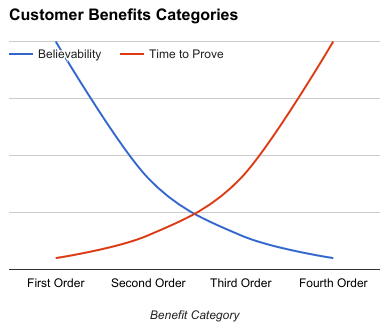
True customer success requires demonstrating value to customers, which justifies the dollars they spend with your company.
However, not all value is created equally and it's important to know what kind of value you're providing your customers.
According to Nucleus Research, there are four categories of value a product creates for its users:
Higher order benefits - First and Second order -- are more tangible, easier to sell and in general easier to understand. Lower order benefits are indirect, take time to prove out for the customer, and may be unbelievable.
 Direct Value, First Order Benefits
Direct Value, First Order BenefitsFirst order benefits are easy to understand, tangible outcomes that have an impact on financial metrics. If a customer can reduce headcount, stop paying for other services, eliminate other costs or increase revenue in some way, you are providing direct, first order value. A good example of this is Charleston, SC-based fixed-cost reduction firm, SIB. They work with clients to reduce spending on existing vendors and contracts through renegotiation and error checking. This is a compelling value proposition realized through direct cost reduction.
Second order value is created when we provide an input to a direct outcome the customer is aiming for. I think of companies that provide qualified leads for sales or inbound marketing tools, such as Hubspot.
Indirect value is created when user productivity is increased. Over time third order benefits can be linked to second or first order benefits. For instance if a SaaS marketing solution can help avoid a budgeted incremental new hire, I can link the productivity gain to a first order cost reduction.
Fourth order benefits don't impact productivity or bottom line, but do increase employee engagement, visibility (executive reporting), customer satisfaction or reduce risk. Use fourth order benefits carefully, and don't mistake them for first second, or third order benefits.
SaaS services typically provide a range of benefits from First to Fourth Order. The further a benefit is from First Order, Direct, the less believable it is and the more time must pass before the value can be proven. More than just telling customers what benefits you provide, they have to believe and buy-in to the fact you provide these benefits. Once they're using your product, there's no faking it. It's critical to understand where we fit in the pecking order of business value for our customers.
More than just telling customers what benefits you provide, they have to believe and buy-in to the fact you provide these benefits.
It is possible to build a great SaaS business without providing first order benefits to customers. But if you don't, this increases the burden on Customer Success to connect the dots on realized second, third or fourth order customer value and link it to financial impacts customers are working toward. It's normal to find the concepts taught in Sales training. Customer Success Managers are always working hard to demonstrate value, long after the initial sale, so it's important we adopt a similar mindset and framework.
Check out Nucleus Research's Standard ROI Analysis Tool which can be customized to meet the needs of your product and value proposition.

I've spent my career working in technology companies to build customer-centric teams, processes and technology platforms. In 2017, I founded Customer Imperative, a consulting firm that helps fast-growing B2B SaaS companies improve renewals, increase expansion sales and scale customer engagement. See full bio ›